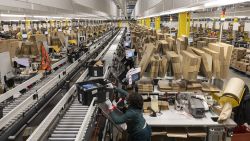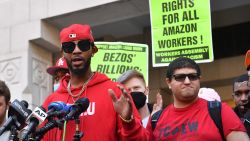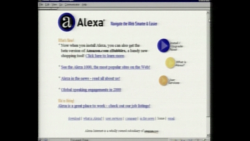Happy Amazon Prime week, the discount-fest that will clutter front stoops and front desks with packages bearing that ubiquitous smiling arrow. It’s a reminder that the incredible rise of e-commerce has come encased in a cardboard box, plus a lot of filler to protect items on the way there.
But it won’t always be that way. Retailers and shippers are working rapidly to shrink, make lighter, and re-use all that extra packaging — and eventually, maybe, get rid of it altogether.
United States of Amazon
Machines can now suck nearly all the extra space around a set of items to be shipped. Paper mills are experimenting with techniques to glue wood fibers together in a way that makes cardboard stronger with fewer trees. Amazon itself has an 85-person team devoted to improving its packaging, and is pushing retailers to pack their products in a way that doesn’t require another box on top.
Kim Houchens has led that Amazon team for four years.
“My goal would be zero packaging of any type over the next couple years,” Houchens says, “by working with the manufacturers to think through product design and their primary package, to make sure that it serves the needs of transportation all the way to your door so that we don’t have redundant packaging added during the process.”
Over the past decade, e-commerce has been a welcome boost for the cardboard industry at a time when demand in sectors like food and manufacturing has stagnated. Shopping online is seven times more cardboard-intensive than picking up items from a store, according to the commodity data analytics company Fastmarkets, and e-commerce generated 1.3 million tons of container board in North America in 2018 — a jump up from 1.1 million the year before.
“In a regular brick-and-mortar supply chain, products are put in blister packs, and then go into a box on a pallet and don’t leave that box until they’re in the store,” explains Derek Mahlburg, an analyst with Fastmarkets. “In e-commerce, the products get shipped to individual houses, so they get taken out of that box very early, and then they get put in a new box.”
That increased demand has also driven prices upward, Mahlburg says, prompting retailers and shippers to try to find ways to waste less cardboard in their packaging — which has environmental benefits, as well.
Why the United States uses so much cardboard
The United States is starting from a low baseline when it comes to cardboard recycling. Because America has abundant space for tree farms, pulp is relatively cheap; the country has long been a big exporter of wood fiber. Also, boxes usually have to travel longer distances than they do in more dense places like Europe, and historically boxes made out of recycled material haven’t been strong enough to survive the journey intact.
There hasn’t been much regulatory or consumer pressure to increase recycling rates, depressing the supply of cardboard to be recycled. In those places, both companies and governments have imposed much more ambitious sustainability targets. A strict new law in Germany requires that manufacturers report how much packaging waste they generate. JD.com — the Amazon of China — is shooting for 100% recyclable or reusable packaging by 2020.
For those reasons, only about 35% of North America’s total manufacturing capability is geared toward recycled content, according to Fastmarkets, compared to 80% in Europe and 93% in Asia.
“It’s not so quick to switch factories that have been using virgin materials for many years,” says Natasha Valeeva, an analyst at the Dutch financial services firm Rabobank. “We expect more pressure from society. The trend is everywhere, but in Europe it may be progressing faster in this direction. It’s from a consumer perspective, but also from regulations.”
Still, the United States is gradually changing, as paper companies have converted old newsprint mills into recycling facilities. They’re also lowering the “basis weight” of cardboard, or the amount of material that has to go into every square foot.
“Corrugated companies are trying to take the paper out of paperboard,” says Quint Marini, who runs the UPS packaging lab, which works with companies to cut down their shipping costs.
Mills have gotten better at making recycled cardboard that stands up to wear and tear, so it’s usable for longer shipping routes. Mark Schlossman is the chief operating officer of Accurate Box, a manufacturer in Paterson, New Jersey, that produces boxes to order for companies ranging from PepsiCo to Jimmy John’s. He says his company’s boxes have gone from 70% virgin paper five years ago to 70% recycled today.
“The recycled liner board world has made tremendous strides in the last number of years, both in its availability and its pricing, and in the quality of its paper,” Schlossman says. “In the box world, strength can be very very critical.”
Even recycling, however, has an environmental impact — it requires huge amounts of water and energy. That’s why shippers are also trying to use less cardboard in the first place.
In the early days of e-commerce, retailers would order large numbers of a few sizes of boxes, throw whatever needed to be shipped into one that seemed big enough, and fill all the empty space with bubble wrap and styrofoam peanuts.
No longer. In consultation with shippers like UPS — which in 2015 started charging by volume, not just weight — companies are shrinking their boxes by using algorithms that can tell them the precise dimensions they need to get an order from point A to point B.
One of the leaders in the world of “right-sizing” packaging is a Salt Lake City-based company called Packsize, which makes machines that retailers buy and use to make custom boxes in their own distribution centers. Their most advanced machine can automatically determine the optimal size for the combination of items that need to fit a box as soon as a customer clicks “buy,” then route all the items onto a conveyor belt that automatically cuts and forms the box to size — no human assistance necessary.
“It’s like an oversized Tetris that has been optimized,” says Packsize CEO Hanko Kiessner. That not only saves on cardboard, it also allows shippers to pack boxes more densely in their trucks, requiring fewer trips. “When you have many smaller sized Tetris cubes, you have gaps, but the gaps are significantly smaller,” he says.
Amazon as regulator
With nearly half of the e-commerce market, the biggest force in box shipments is Amazon.
The company buys millions of boxes a year from manufacturers close to its fulfillment centers. It employs statisticians, operations researchers, data scientists, material engineers and computational engineers — the types of people who design airplane wings — to think about boxes, bags and envelopes.
“We put those groups together, probably for the first time in the corrugate box business, to ask, ‘what is happening to the corrugate box in the back of a truck?’” says Houchens.
The different stresses and strains on boxes in different parts of the truck told them how big each one really needed to be, and how thin the cardboard could get without jeopardizing the product inside. Amazon also uses machine learning algorithms to monitor feedback that comes from customers via call centers and social media on any damage that occurs in transit, to see when they’ve gone too far.
Using pilot production lines and partnerships with big tape and glue manufacturers, Amazon creates new designs and materials that its suppliers then figure out how to produce at scale — like a fully recyclable plastic-free padded envelope mailer, for example, rather than the standard bubble-wrap-and-paper version. With all of that combined, Houchens says they’ve managed to reduce packaging material by 19% in tons over their baseline year of 2016.
Still, there’s plenty of room for improvement.
Companies are starting to design packaging differently for products that are bound for a customer’s doorstep rather than a store shelf, so that those sold through e-commerce don’t need an “overbox” at all. Tide laundry detergent now comes in a container that looks like boxed wine, rather than a plastic bottle that ships in a paper box.
Amazon has the scale and buying power to push those changes faster — and has been, since it helps its bottom line, as well. For the past year, for large items and those weighing 20 pounds or more, the company has been paying retailers $1 per package that is easily recyclable and able to ship without a brown Amazon overbox. Starting in August, it will stop paying that incentive, and instead charge $1.99 per package that doesn’t comply.
Retailers are starting to see better packaging as an opportunity, too. Shipping in their own boxes also allows brands to make a stronger connection with their customers, with specialized messages on the inside to enhance the experience of getting something in the mail. They’re trying to capitalize on the “unboxing” trend, wherein people record themselves opening a package and posting the video to YouTube, making the box that much more visible.
“It is a billboard, in a sense. It’s the last impression that people have, your last point of contact with someone is when the box arrives at peoples’ home,” says Rachel Kenyon, vice president of the Fibre Box Association, which represents paper-based packaging manufacturers. “If you can take that one step further by enhancing that unboxing experience, it’s a great opportunity.”
Consumers are tired of garbage
Rightsizing, lightweighting, and getting rid of overboxes have reduced the rate of cardboard consumption so much that analysts believe production will slow, even as more goods are ordered online. As shopping through the mail becomes more common, companies and postal services are experimenting with ditching single-use cardboard containers altogether.
Amazon is running a pilot in India where products are delivered to homes in plastic totes, since it’s more common in India for someone to be home during the day to receive them. (Security and privacy are a big reason why overboxes are used at all.) And in China, a company called Suning.com is using shared plastic delivery boxes in 13 cities that can be almost infinitely reused. In the United States, the rise of delivery lockers may allow for box-free delivery to spread as well.
Until everything is reusable, paper-based packaging companies are making the argument that at least cardboard is better than single-use plastic, even as they take steps to make packaging less damaging to the planet. And consumers, they point out are starting to reject products that come swathed in garbage.
“With social media, you can see people are not accepting certain things any more, and potentially not re-ordering because of it,” says Herwin Wichers, market development director for Smurfit Kappa, a global Dublin-based paper packaging manufacturer that serves both Europe and the US. “Price is still an important part, convenience is still an important part, but the sustainability angle is starting to influence peoples’ decisions.”
At the same time, however, there’s still a clear difference between the progress made in the US vs. Europe and Asia, with their stronger government mandates and culture of waste reduction.
Without similar pressure, even with Amazon pushing for change, the US will struggle to catch up.



















